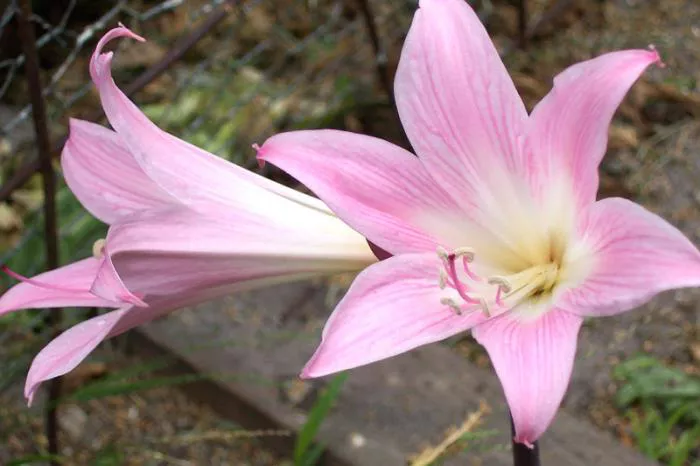The belladonna lily, also known as Amaryllis belladonna, is a beautiful flower with rich symbolism. This plant is prized for its striking blooms and unique growth pattern. Its cultural, spiritual, and aesthetic significance makes it a fascinating topic for gardeners, florists, and flower enthusiasts.
In this article, we will explore the meaning of the belladonna lily, its symbolism, and its significance in various cultures and contexts.
Overview of the Belladonna Lily
The belladonna lily is native to South Africa but has become popular in gardens worldwide. It is commonly referred to as the “naked lady” due to its habit of producing flowers without accompanying leaves. The stems emerge bare from the ground, followed by stunning trumpet-shaped blooms in shades of pink, white, or pale lavender.
This flower typically blooms in late summer or early fall, making it a striking addition to any garden during seasons when many other flowers have faded. Its hardy nature and vibrant appearance contribute to its popularity.
Symbolism of the Belladonna Lily
The belladonna lily is steeped in symbolism, with meanings rooted in its unique qualities and appearance.
Beauty and Elegance
The delicate blooms of the belladonna lily symbolize beauty and grace. Their soft, pastel colors and elegant shape evoke feelings of refinement and sophistication. This makes them a popular choice for bouquets and arrangements meant to convey admiration or affection.
Rebirth and Renewal
Because the belladonna lily blooms unexpectedly without leaves, it often represents rebirth and renewal. Its ability to thrive under harsh conditions and its timing during transitional seasons, such as late summer, symbolize hope and new beginnings. This flower is a reminder that beauty can emerge even in the most challenging circumstances.
Feminine Energy
The nickname “naked lady” reflects the belladonna lily’s association with femininity. Its bare stems, followed by lush blossoms, signify strength and vulnerability, qualities often attributed to feminine energy. This symbolism makes it a meaningful flower for celebrating women and their resilience.
Cultural and Historical Significance
The belladonna lily has cultural significance in several regions, particularly in areas where it grows naturally or has been cultivated.
South Africa
In its native South Africa, the belladonna lily is admired for its resilience. It thrives in the arid conditions of the Cape region and is often seen as a symbol of survival and endurance.
Victorian Flower Language
In Victorian times, flowers were used to convey unspoken messages, and the belladonna lily was no exception. It represented delicate beauty and refinement, making it a popular gift among lovers or as a gesture of admiration.
Religious and Spiritual Symbolism
The belladonna lily has spiritual associations due to its emergence from seemingly barren ground. In some traditions, it is linked to themes of resurrection and divine beauty. It has been used in religious ceremonies and as an offering in spiritual practices.
Uses in Floristry
The belladonna lily’s striking appearance makes it a favorite among florists for various purposes.
Bouquets and Arrangements
Its elegant blooms are perfect for wedding bouquets, centerpieces, and other decorative arrangements. The belladonna lily adds a touch of sophistication and works well with other flowers like roses and lilies.
Symbolic Gifting
Due to its meanings of renewal, beauty, and feminine energy, the belladonna lily is often gifted on special occasions. It is a thoughtful choice for birthdays, anniversaries, or celebrations of new beginnings, such as graduations or housewarmings.
Growing Belladonna Lilies
Understanding how to cultivate belladonna lilies enhances their appreciation. These plants are easy to grow and require minimal care, making them suitable for novice gardeners.
Planting Requirements
Belladonna lilies thrive in well-draining soil and prefer full sun. They are drought-tolerant and adapt well to dry conditions, making them ideal for gardens in warmer climates.
Seasonal Blooming
One of the most unique aspects of the belladonna lily is its seasonal growth pattern. The bulbs remain dormant for much of the year before producing flowers in late summer or early fall. Leaves appear after the blooms have faded, giving the plant its distinctive “naked” appearance.
Maintenance Tips
These lilies require little maintenance once established. Occasional watering during prolonged dry spells and removing spent blooms will keep them looking their best. They are also resistant to pests and diseases, adding to their appeal.
Modern Interpretations
In modern times, the belladonna lily continues to be a symbol of beauty, renewal, and feminine strength. It is often included in gardens for its aesthetic value and in ceremonies for its deeper meanings.
As society increasingly values resilience and the ability to thrive in adversity, the belladonna lily’s symbolism has grown more relevant. Its blooming cycle serves as a metaphor for personal growth and the beauty that can emerge from life’s challenges.
Conclusion
The belladonna lily is more than just a beautiful flower; it carries profound meanings of beauty, resilience, and renewal. Its cultural and spiritual significance adds depth to its aesthetic appeal, making it a meaningful addition to gardens, bouquets, and celebrations.
Whether you are a gardener, florist, or simply a flower enthusiast, the belladonna lily offers inspiration and elegance. Its timeless symbolism ensures that it will continue to captivate hearts for generations to come.
Related topics:


